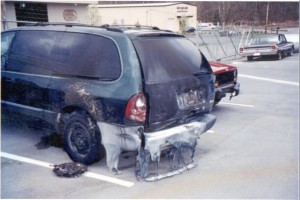Static electricity has become a safety issue when filling up at gas stations.
Gas Stations across North America have seen a sharp increase of incidents (fire and explosion) not attributed to a running engine or cigarette smoking (the leading known causes of such fires). Many refueling fires have been documented that appear to be caused by a discharge of static electricity as people fill their vehicles. Therefore, gas stations need to alert patrons of the potential danger posed by the discharge of static electricity.
Safety Controls
- Engineered Controls – many gas stations have removed the automatic shut off levers which reduces the potential for people to re-enter their vehicles during dispensing. Other companies have an alarm when the patron removes his/her hand while pumping. Fire extinguishers and emergency shut-down switches are often accessible at filling stations.
- Administrative Controls –brightly colored signs are often posted throughout the gas station stating warnings about static electricity and its causes. Gas attendants are being trained and asked to ensure patrons follow the rules.
- Personal Protective Equipment (PPE) – this option is usually not feasible because of the number of patrons and the lack of suitable PPE.
Safety Tips While Re-Fueling Your Vehicle
Some gas stations have begun posting warnings relating to the dangers associated with static electricity. The postings state items such as:
- NEVER get back into your vehicle while filling it with gas. If you absolutely HAVE to get in your vehicle while the gas is pumping, make sure you get out, close the door TOUCHING THE METAL, before you ever pull the nozzle out. This way the static from your body will be discharged before you ever remove the nozzle.
- In the rare event you experience a fire when refueling, leave the nozzle in the fill pipe of your vehicle and back away from the vehicle. Notify the station attendant immediately to shut off all dispensing devices and pumps with emergency controls.
The American Petroleum Institute and the Petroleum Equipment Institute announced September 23, 2002 that they were joining to remind motorists how to avoid potential problems with static electricity at the gas pump. The groups also are encouraging motorists to follow all safe refueling practices with every fill-up.
Many flash fires and explosions have occurred, almost all of them were by female patrons. Men are seldom involved in these types of fires because most men do not get back in their vehicle until completely finished. No correlation between pump types, make of vehicles, driveway surfaces, or patrons clothing were identified.
Almost all cases involved the person getting back in their vehicle while the nozzle was still pumping gas. Fifteen percent of fires occurred before, during or immediately after the gas cap was removed and before fueling began.
Need some visual proof? This is the result of a static electricity ignited fire!
Credit must be given to the Petroleum Equipment Institute (http://www.pei.org) and the American Petroleum Institute for their extensive research on this topic.

